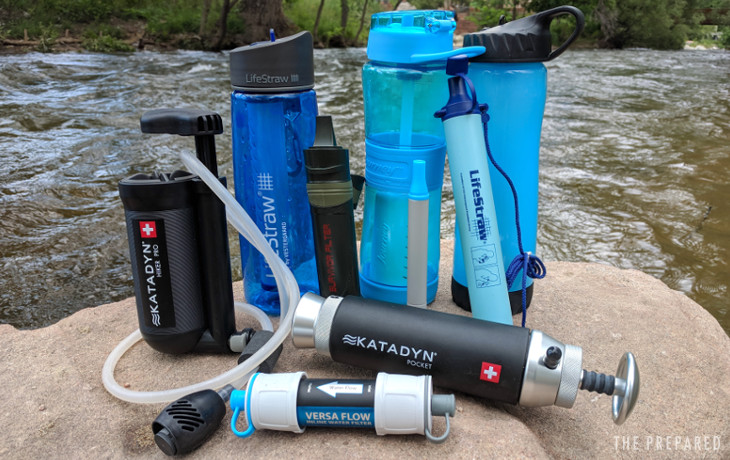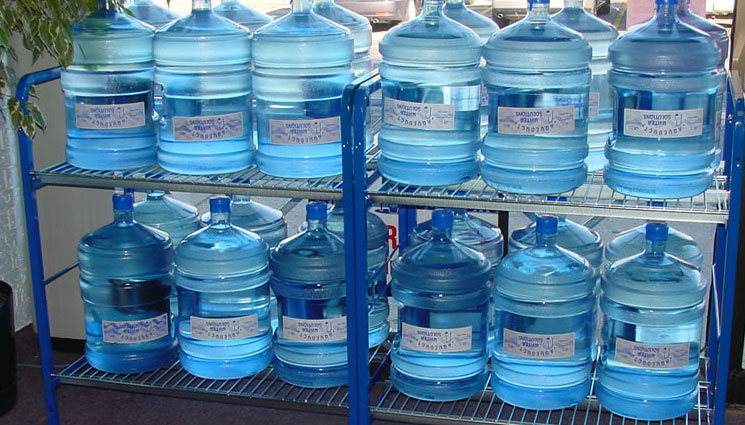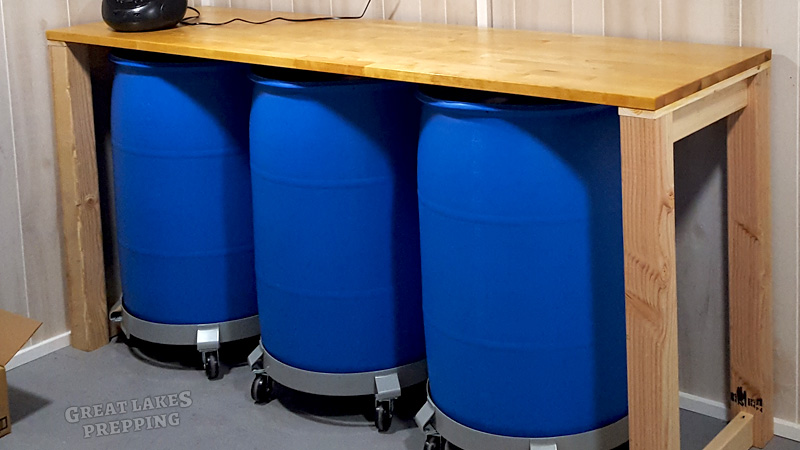Prepping for an emergency situation can be a daunting task. One of the most important preparations to make is to make sure you have enough water stored away to last you and your family in the event of an emergency. Knowing how much water to store and how to store it correctly is essential in order to make sure you have enough water to last during an emergency. In this blog, we will explore the different types of water storage, how much water you should store, and how to store it safely and effectively.
Preparing for any disaster, whether it be natural or man-made, requires having a good supply of water at the ready. Water is essential for drinking, cooking, cleaning, and home water sanitation, so having a good supply is paramount. But how much water should you store for prepping?
When it comes to storing water for prepping, the general rule of thumb is to store at least one gallon of water per person, per day. This means that for a family of four, you should store at least four gallons of water per day. This should be enough for basic drinking, cooking, and sanitation needs. However, depending on your location and the type of disaster you are preparing for, you may need to store more water.
For instance, if you live in an area that is prone to floods or hurricanes, it is a good idea to store an additional two to four gallons of water per person, per day. This extra water can be used for bathing, laundry, and other uses that require clean water.
It is also important to make sure that the water you store is clean and safe. When storing water for prepping, try to use food-grade water containers or large plastic jugs with tight-fitting lids. If you are storing water for longer-term prepping, you may want to consider using a water purification system or water filter.
When it comes to storing water for prepping, the most important thing to remember is to store enough water for your family’s needs. It is not always easy to determine how much water you should store, but a good rule of thumb is to store at least one gallon of water per person, per day. This should provide enough water for basic drinking, cooking, and sanitation needs. However, depending on your location and the type of disaster you are preparing for, you may need to store more water.

How much water should preppers store?
As a prepper, you know how important it is to be prepared for any situation. And one of the most important things to be prepared for is a water shortage. Whether it’s a natural disaster, a power outage, or a water main break, having an ample supply of water can make all the difference in an emergency. But just how much water should you store as a prepper?
When it comes to water storage, there are a few different factors to consider. First, you need to think about the size of your family. The amount of water you will need to store will depend on how many people you need to provide for. Generally speaking, you will want to store at least one gallon of water per person, per day. That means if you have a family of four, you should store at least four gallons of water per day.
The next factor to consider when it comes to water storage is the length of time you plan to be without access to clean water. If you are expecting to be without water for only a few days, you can probably get away with storing a few days’ worths of water. However, if you plan to be without access to water for a longer period of time, you should store enough to last a minimum of two weeks.
You will need to factor in the type of water you will be storing. If you are able to obtain clean drinking water, then you should store that. But if you are unable to access clean drinking water, you will need to store water that can be purified. In this case, you should store water that has been treated with a water purification system or water that has been boiled for at least 10 minutes.
As a prepper, it is important to be prepared for any situation. Having an ample supply of water is an essential part of that preparation. While there is no one-size-fits-all answer to the question of how much water should preppers store, you should plan to store at least one gallon of water per person, per day, for at least two weeks. Additionally, you should make sure you are storing water that has been treated with a water purification system or boiled for at least 10 minutes. By following these guidelines, you can rest assured that you and your family will have the necessary water needed to stay safe and healthy in an emergency.
How do you store water for prepping?

As the world’s population continues to grow, it is increasingly important to understand how to store water for prepping and emergency situations. Water is essential for survival and being prepared with an emergency water supply can mean the difference between life and death.
It is important to understand how much SHTF water you need to store and how to store it so that it remains pure and safe for consumption.
How Much Emergency Water Supply Do I Need?
In general, it is recommended to store at least one gallon of water per person, per day for at least three days. This should be enough to provide for basic needs such as drinking, cooking, and emergency water sanitation. It is also recommended to store a two-week supply of water for each person in the household.
Keeping Water Pure in Long-Term Water Storage
Water stored for a long period of time can become contaminated and unsafe to drink. To ensure that your water remains safe for consumption, it is important to store it in containers that are resistant to waterborne pathogens.
It is also important to consider the environment in which you are storing your water. Extreme temperatures, light, and oxygen can all cause your stored water to spoil, so it is important to store your water in a cool, dark place.
Where and How Should I Stockpile Water for Long-Term Water Storage?
When stockpiling water for long-term storage, it is important to choose the right water storage containers. Plastic containers are the most affordable and widely used option. However, it is important to make sure that the plastic containers are food-grade and free of BPA.
For a more economical and eco-friendly option, many people opt to use large food-grade water barrels. These barrels are designed to keep water safe and can hold up to 55 gallons of water.
It is also important to remember to rotate and replace your home water supply every six months. This will ensure that you have access to fresh, safe drinking water in the event of a disaster.
Storing water for prepping is an essential part of being prepared for any type of emergency. It is important to understand how much emergency water you need to store, how to store it safely, and where and how to store it for long-term water storage. By following these tips, you can ensure that you have access to safe drinking water in case of an emergency.
Safely Store Emergency Water Storage
As we mentioned before, it is very important to know how much water you have stored in your home prior to an emergency. If you are trying to determine how much water you have, there are several factors that play a role.
It is good practice to measure all of the liquids in each room of the house as well as any free-standing containers such as pots or bowls. Note: Do not forget about the pantry! The average person does not accumulate enough liquid food during non-emergency times so make sure to account for this when calculating how much water you have.
Another way to check if you have enough water storage is by counting the bottles yourself. There are many resources where you can get bottle diagrams that help identify what size container every one of these products fits into.
Using those charts, along with our tips above, will ensure you do not run out of space while still having enough stock up for an adequate amount of time.

How Do You Purify Emergency Water Storage?
Water is an essential resource for life and having access to clean and safe drinking water is a necessity. Emergency water storage provides an important source of water during emergency situations when the public water supply becomes unavailable. While storing water is an important step in emergency preparedness, it is also essential to ensure the stored water is safe for consumption.
Purifying water stored in an emergency water storage container is an important step for making sure the water is safe for drinking. There are several methods for purifying stored water, including boiling, chemical treatments, and filtration. Knowing the steps to follow and the techniques to use can help ensure that stored water is safe for drinking.
Boiling
Boiling is the most common method for purifying stored water. To effectively purify the water, it must be boiled for at least one minute (at altitudes of 1,000 feet or higher, the water should be boiled for three minutes). Boiling will kill most bacteria, viruses, and parasites that can cause water-borne illnesses. Once the water has been boiled, it should be stored in a clean, sanitized container.
Chemical Treatments
If boiling water isn’t an option, chemical treatments can be used to purify water. The most common chemical treatment for storing water is chlorine-based products, such as household bleach. To treat the water, a specific amount of the chemical should be added to the water, mixed thoroughly, and allowed to stand for at least 30 minutes. The treated water should then be stored in a clean, sanitized container.
Filtration
Another option for purifying stored water is filtration. Filtration systems use different filters to remove impurities from the water, such as bacteria, sediment, and other organic materials. These filters can be found in hand-held bottles, pitchers, or even entire filtration systems. Once the water has been filtered, it should be stored in a clean, sanitized container.
No matter which method you use to purify water stored in an emergency water storage container, it is important to remember that the water should always be tested for safety before drinking. Testing kits are widely available and can be used to test for a variety of contaminants. If the water is not safe for drinking, it should not be consumed and should be disposed of properly.
By following the steps and using the methods outlined above, you can ensure that the water stored in your emergency water storage container is safe for use. Storing water is an important step in emergency preparedness, but it is also essential to make sure the water is safe for consumption. Following these steps will help ensure your water is safe for drinking and can help keep you, your family, and your community safe during an emergency.

Emergency Water Storage Tips and Suggestions
As climate change continues to shift the world’s weather patterns, emergency water storage has become an increasingly important part of prepping for natural disasters, power outages, and other unpredictable events. Having an adequate supply of clean water stored away is essential for any household that wants to be prepared for any emergency situation.
The simplest and most cost-effective way to store water for emergencies is to buy large, food-grade containers from a local store and fill them with tap water. However, there are other more advanced and efficient ways to store water for emergencies. Here are some of the best tips and suggestions for emergency water storage:
1. Use a Water Purification System: Water purification systems are designed to remove harmful contaminants from drinking water. These systems can be used to filter water to make it safe for drinking and other uses. Many of these systems also come with storage containers, so you can easily store the water until it is needed.
2. Store Water in the Ground: If you have access to an area of land, you can use it to store water. Dig a trench and line it with plastic sheeting or tarps. Fill the trench with water and cover the top with more plastic sheeting or tarps. This will help protect the water from the elements and keep it from evaporating.
3. Store Water in Buckets: Buckets are a great way to store water for emergency situations. Fill the buckets with tap water and store them in a cool, dark place. Make sure to change out the water regularly to keep it from becoming stagnant.
4. Store Water in Water Tanks: Water tanks are a great way to store a large amount of water for emergency situations. You can buy tanks in different sizes and make sure to keep them away from direct sunlight.
5. Collect Rainwater: Rainwater can be collected from roofs and stored in barrels or tanks. Make sure to cover the tanks to keep debris and pests out.
6. Buy Water Purification Tablets: Water purification tablets are a great way to disinfect water and make it safe for drinking. Make sure to change out the tablets regularly to keep them fresh.
These are just a few of the best tips and suggestions for emergency water storage. Storing a large amount of water ahead of time is essential for any household that wants to be ready for any emergency situation. Make sure to use these tips and suggestions to ensure that your family is prepared for any disaster that may come their way.
How to Find Water in the Wild?
Finding water is the most important thing when stocking up on supplies before a crisis! Luckily, you don’t need a fancy tool to do this, there are some easy ways to know where to look.
The number one tip we have is to learn how to read trees. There are several types of tree patterns that indicate if a creek or river has enough moisture to support life.
If you see lots of leaves changing color then it’s definitely time to find another source of hydration!
Another way to tell is by looking at the moss growing along rivers and streams. Moss will only grow where there is adequate rainfall so keep an eye out for it when trying to determine if your current source of drinkable liquid is gone.
General tips: If there isn’t any indication that waterways are flowing with water then try going down these hills during different times of day to get a better idea of just how thirsty the area is.
Reasons Every Prepper Should Start Storing Water
Having enough water is one of the most important things you can do as a prepared individual. You need to know how many bottles of water you have, what size the bottle they are, and how many days each person in your family has to drink that amount.
It’s very difficult to estimate how much water someone else needs, so be sure to ask people who live with you about their fluid requirements.
Finding out how much water an average person needs daily takes practice, but there are some basic guidelines. The National Institutes of Health (NIH) suggest adults consume at least eight 8-ounce glasses of water per day.
Loss of Clean Water is Common in Disaster Situations
Thankfully, just because you’re preparing for an emergency doesn’t mean you have to worry about running out of clean drinking water!
Most people assume that they will be able to find enough clean water during a disaster, but this isn’t always the case.
Biological Need – Hydration
We develop our sense of taste by tasting substances in our saliva. As we know, your mouth is made up of many different tissues and liquids that comprise the first stage of taste perception.
Your tongue has millions of taste buds that help detect chemicals in your saliva or food you are chewing. These taste receptors also play an important role in sensing moisture and hunger.
When you drink enough liquid, your appetite can be suppressed. This may seem like a vague reason, but it works via some complex mechanisms.
Drinking just enough fluid to keep yourself hydrated can reduce your body’s craving for foods that contain lots of sugar (or salt). Because drinking less calorie-rich food makes you feel full, you will tend to eat fewer calories overall.
This could have serious health benefits if you struggle with weight loss or need to gain weight. It can even help prevent obesity!
However, too much alcohol can impair your ability to regulate blood glucose levels, so people who are alcoholics already might want to pay more attention to their drinks.
